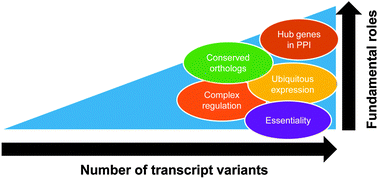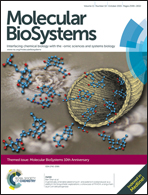Human genes with a greater number of transcript variants tend to show biological features of housekeeping and essential genes†
Abstract
Alternative splicing is a process observed in gene expression that results in a multi-exon gene to produce multiple mRNA variants which might have different functions and activities. Although physiologically important, many aspects of genes with different number of transcript variants (or splice variants) still remain to be characterized. In this study, we provide bioinformatic evidence that genes with a greater number of transcript variants are more likely to play functionally important roles in cells, compared with those having fewer transcript variants. Among 21 983 human genes, 3728 genes were found to have a single transcript, and the remaining genes had 2 to 77 transcript variants. The genes with more transcript variants exhibited greater frequencies of acting as housekeeping and essential genes rather than tissue-selective and non-essential genes. They were found to be more conserved among 64 vertebrate species as orthologs, subjected to regulations by transcription factors and microRNAs, and showed hub node-like properties in the human protein–protein interaction network. These findings were also confirmed by metabolic simulations of 60 cancer metabolic models. All these results indicate that genes with a greater number of transcript variants play biologically more fundamental roles.

- This article is part of the themed collection: 10th Anniversary of Molecular BioSystems

 Please wait while we load your content...
Please wait while we load your content...